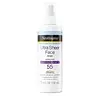What's inside
What's inside
 Key Ingredients
Key Ingredients

 Benefits
Benefits

No benefits
 Concerns
Concerns

 Ingredients Side-by-side
Ingredients Side-by-side

Water
Skin ConditioningDiethylamino Hydroxybenzoyl Hexyl Benzoate
UV FilterOctocrylene
UV AbsorberGlycerin
HumectantAlcohol
AntimicrobialDibutyl Adipate
EmollientDicaprylyl Carbonate
EmollientButyl Methoxydibenzoylmethane
UV AbsorberPhenylbenzimidazole Sulfonic Acid
UV AbsorberBis-Ethylhexyloxyphenol Methoxyphenyl Triazine
Skin ConditioningEthylhexyl Triazone
UV AbsorberMethyl Methacrylate Crosspolymer
Bis-PEG/PPG-16/16 PEG/PPG-16/16 Dimethicone
EmollientDimethicone
EmollientPotassium Cetyl Phosphate
EmulsifyingPolymethylsilsesquioxane
Tapioca Starch
Centaurea Cyanus Flower Water
Skin ConditioningHdi/Trimethylol Hexyllactone Crosspolymer
Aphloia Theiformis Leaf Extract
AstringentAcrylates/Hydroxyesters Acrylates Copolymer
Sodium Hydroxide
BufferingCetyl Alcohol
EmollientCaprylic/Capric Triglyceride
MaskingParfum
MaskingAminomethyl Propanol
BufferingXanthan Gum
EmulsifyingPentylene Glycol
Skin ConditioningEryngium Maritimum Extract
TonicSodium Benzoate
MaskingCitric Acid
BufferingTocopherol
AntioxidantPotassium Sorbate
PreservativePentaerythrityl Tetra-Di-T-Butyl Hydroxyhydrocinnamate
AntioxidantWater, Diethylamino Hydroxybenzoyl Hexyl Benzoate, Octocrylene, Glycerin, Alcohol, Dibutyl Adipate, Dicaprylyl Carbonate, Butyl Methoxydibenzoylmethane, Phenylbenzimidazole Sulfonic Acid, Bis-Ethylhexyloxyphenol Methoxyphenyl Triazine, Ethylhexyl Triazone, Methyl Methacrylate Crosspolymer, Bis-PEG/PPG-16/16 PEG/PPG-16/16 Dimethicone, Dimethicone, Potassium Cetyl Phosphate, Polymethylsilsesquioxane, Tapioca Starch, Centaurea Cyanus Flower Water, Hdi/Trimethylol Hexyllactone Crosspolymer, Aphloia Theiformis Leaf Extract, Acrylates/Hydroxyesters Acrylates Copolymer, Sodium Hydroxide, Cetyl Alcohol, Caprylic/Capric Triglyceride, Parfum, Aminomethyl Propanol, Xanthan Gum, Pentylene Glycol, Eryngium Maritimum Extract, Sodium Benzoate, Citric Acid, Tocopherol, Potassium Sorbate, Pentaerythrityl Tetra-Di-T-Butyl Hydroxyhydrocinnamate
Ingredients Explained
These ingredients are found in both products.
Ingredients higher up in an ingredient list are typically present in a larger amount.
Dimethicone is a type of synthetic silicone created from natural materials such as quartz.
What it does:
Dimethicone comes in different viscosities:
Depending on the viscosity, dimethicone has different properties.
Ingredients lists don't always show which type is used, so we recommend reaching out to the brand if you have questions about the viscosity.
This ingredient is unlikely to cause irritation because it does not get absorbed into skin. However, people with silicone allergies should be careful about using this ingredient.
Note: Dimethicone may contribute to pilling. This is because it is not oil or water soluble, so pilling may occur when layered with products. When mixed with heavy oils in a formula, the outcome is also quite greasy.
Learn more about DimethiconeOctocrylene protects skin from sun damage. It absorbs UV-B with peak absorption of 304 nm. It is a common sunscreen ingredient and often paired with avobenzone, a UVA filter. This is because octocrylene stabilizes other sunscreen ingredients by protecting them from degradation when exposed to sunlight. Octocrylene is a photostable ingredient and loses about 10% of SPF in 95 minutes.
Octocrylene also acts as an emollient, meaning it helps skin retain moisture and softens skin. It is oil-soluble and hydrophobic, enhancing water-resistant properties in a product.
Those who are using ketoprofen, a topical anti-inflammatory drug, may experience an allergic reaction when using octocrylene. It is best to speak with a healthcare professional about using sunscreens with octocrylene.
The EU allows a maximum of these concentrations:
Learn more about OctocryleneParfum is a catch-all term for an ingredient or more that is used to give a scent to products.
Also called "fragrance", this ingredient can be a blend of hundreds of chemicals or plant oils. This means every product with "fragrance" or "parfum" in the ingredients list is a different mixture.
For instance, Habanolide is a proprietary trade name for a specific aroma chemical. When used as a fragrance ingredient in cosmetics, most aroma chemicals fall under the broad labeling category of “FRAGRANCE” or “PARFUM” according to EU and US regulations.
The term 'parfum' or 'fragrance' is not regulated in many countries. In many cases, it is up to the brand to define this term.
For instance, many brands choose to label themselves as "fragrance-free" because they are not using synthetic fragrances. However, their products may still contain ingredients such as essential oils that are considered a fragrance by INCI standards.
One example is Calendula flower extract. Calendula is an essential oil that still imparts a scent or 'fragrance'.
Depending on the blend, the ingredients in the mixture can cause allergies and sensitivities on the skin. Some ingredients that are known EU allergens include linalool and citronellol.
Parfum can also be used to mask or cover an unpleasant scent.
The bottom line is: not all fragrances/parfum/ingredients are created equally. If you are worried about fragrances, we recommend taking a closer look at an ingredient. And of course, we always recommend speaking with a professional.
Learn more about Parfum